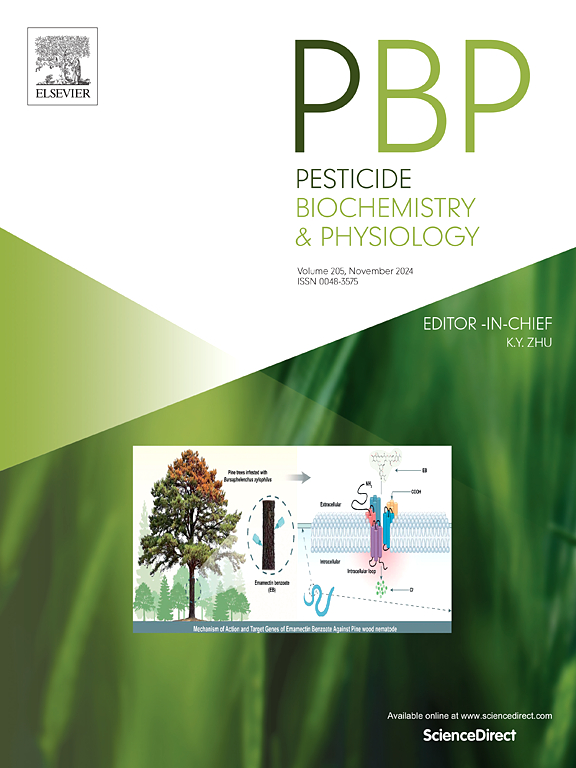Molecular identification of three cytochrome P450 genes and their potential roles in insecticides tolerance in Grapholita molesta (Busck)
IF 4.2
1区 农林科学
Q2 BIOCHEMISTRY & MOLECULAR BIOLOGY
引用次数: 0
Abstract
The oriental fruit moth, Grapholita molesta (Busck), is a significant pest of Rosaceae trees worldwide and has developed resistance to various insecticides. Cytochrome P450 play a major role in detoxification of resistance to insecticides in insects. In this study, we found that Piperonyl butoxide (PBO), which inhibits the P450 activity, synergized with abamectin, imidacloprid, and L-cyhalothrin, increasing mortality rates of G. molesta by 43.04 %, 31.66 %, and 59.09 %, respectively. Using previously constructed transcriptome data from G. molesta treated with these three insecticides, we identified and cloned three new cytochrome P450 genes—CYP4L57 (OR027029), CYP9A114 (OR027031), and CYP9A203 (OR027030). These genes were highly expressed in adults, with CYP4L57 showing a 123.90-fold increase, CYP9A114 a 43.89-fold increase, and CYP9A203 a 1498.99-fold increase compared to egg stages. Tissue-specific expression analysis revealed CYP4L57 was predominantly expressed in the head, CYP9A114 in the hindgut, fat body, and Malpighian tubules, and CYP9A203 in the midgut, ovary, and hindgut. Molecular docking demonstrated strong binding interactions between these P450 genes and the insecticides. RNA interference-mediated silencing of CYP4L57, CYP9A114, and CYP9A203 significantly increased mortality rates by 12.42 % to 68.89 % upon exposure to the insecticides, abamectin, imidacloprid, and L-cyhalothrin. These findings suggest that cytochrome P450 genes contribute to insecticide tolerance in G. molesta and CYP4L57, CYP9A114, and CYP9A203 play key roles in this process.

求助全文
约1分钟内获得全文
求助全文
来源期刊
CiteScore
7.00
自引率
8.50%
发文量
238
审稿时长
4.2 months
期刊介绍:
Pesticide Biochemistry and Physiology publishes original scientific articles pertaining to the mode of action of plant protection agents such as insecticides, fungicides, herbicides, and similar compounds, including nonlethal pest control agents, biosynthesis of pheromones, hormones, and plant resistance agents. Manuscripts may include a biochemical, physiological, or molecular study for an understanding of comparative toxicology or selective toxicity of both target and nontarget organisms. Particular interest will be given to studies on the molecular biology of pest control, toxicology, and pesticide resistance.
Research Areas Emphasized Include the Biochemistry and Physiology of:
• Comparative toxicity
• Mode of action
• Pathophysiology
• Plant growth regulators
• Resistance
• Other effects of pesticides on both parasites and hosts.

 求助内容:
求助内容: 应助结果提醒方式:
应助结果提醒方式:


